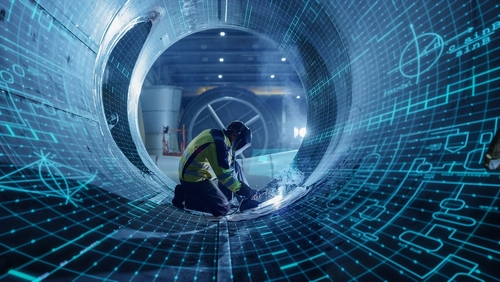In a world of rising geopolitical tensions and unpredictable politics, the global economy is braced for constant, sudden change. The current US administration has introduced unprecedented tariffs, with more in the pipeline, shaking up international material deliveries and supply chains.
This shift in world order will profoundly affect Engineering, Procurement, and Construction (EPC) businesses, given their natural dependence on long lead-time global components within tight timeframes. EPCs also face mounting pressures from rising costs, skilled labor shortages, and sustainability mandates.
Amid these high-pressure variables and moving parts, companies must remain agile and flexible to complete projects on time and within budget.
Although modern technologies can go some way to mitigate the unpredictability of policy shifts and budget constraints, the traditionally conservative EPC industry has been slow to embrace digital transformation.
In today’s volatile climate, digitalisation is no longer optional for EPCs – it’s a strategic necessity.
Mounting hurdles and complexity
The challenges faced by EPCs are myriad, time-sensitive, and increasingly complex.
Fragmented project execution often leads to inefficiencies and costly rework, while volatile supply chains can derail material procurement and extend project timelines. In addition, a shortage of workers puts stress on knowledge retention and jeopardises project continuity.
The industry is also beset with outdated legacy technology, which can significantly impair collaboration and hamper effective decision-making. What’s more, siloed systems hinder connectivity, visibility and transparency – the lifeblood of AI-enabled, high productivity solutions.
The good news is that embracing technology can significantly mitigate EPC hurdles. McKinsey reports that implementing digital tools can boost productivity by 14-15 percent, while reducing costs between four to six percent.

Building resilience and agility in fast-paced times
Digital transformation can tackle entrenched EPC challenges, enabling firms to build critical resilience and agility.
In the first instance, cloud-based technologies are transforming the way engineering teams collaborate. By unifying engineering processes and enabling collective project execution, firms can break down geographical and organisational barriers. This radical collaboration accelerates decision-making and streamlines workflows, ensuring project teams are more responsive and better equipped to manage complex tasks.
In addition, automation, infused with AI, is transforming the EPC landscape.
AI-powered tools enhance engineering precision, reducing the risk of rework and curbing unforeseen costs. By streamlining routine processes and offering data-driven insights, these technologies boost efficiency and free up valuable human resources for more strategic tasks.
Collaborative gains from digital twins
With an integrated engineering workflow, EPCs can create a digital twin of their projects that spans the design, engineering and handover stages. Digital twins are real-time virtual representations of physical assets, processes, or environments that look like and behave like their real-world counterparts. They allow EPC firms to simulate, predict, and optimise project performance.
By combining engineering and operations data from across the engineering lifecycle and enhancing it with first-principles modeling and AI-infused analytics, digital twins can give teams in-depth industrial intelligence around value and sustainability.
The power of a digital twin can be seen clearly in its demonstrable cost savings. For instance, McKinsey projects that implementing digital twins can generate up to operational expense reductions of up to 20 percent.
After project handover, digital twins can also provide major benefits to EPC clients during the operations and maintenance (O&M) phase. Digital twins ensure that end-users don’t just receive a static asset but gain a living, evolving digital model that supports long-term performance, lower total cost of ownership and extended asset lifespan.
As such, EPC companies are increasingly asked by their clients to provide a digital twin for smoother handover and optimised operations – a win-win scenario for all stakeholders.
EPC digitalisation in action
The practical benefits of digital transformation are already evident in the EPC world.
Aberdeen-headquartered Wood, for example, has seamlessly integrated capital project engineering and execution data to enable its teams to openly and flexibly collaborate.
By improving collaboration, the company has expedited execution cycles and sped up build processes. Wood has also generated significant cost savings by standardising materials and streamlining design processes.
With the development of its Digital Control Tower, Wood teams use digital twins to more efficiently use materials and plan construction. In-house pattern recognition software can predict project delays and ensure performance stays on track.
In India, L&T Hydrocarbon Engineering, has taken a major digital step through boosting collaboration and insight during a critical handover for the nation’s largest crude producer, Oil & Natural Gas Corporation (ONGC).
L&T, which specialises in upstream EPC projects for the oil and gas industry, had already seen the benefits of ONGC’s data-centric approach to project handover, which is why the company began its own initiative to define and implement a single-point repository of data.
At the same time, the project sped up communication and decision-making, seamlessly integrated 3D models and engineering data, and enabled efficient online search for faster navigation, querying, sorting, consolidation, and reporting.
The result was a high-performance handover solution which united many different data sources to better meet the needs of India’s largest crude oil producer.
Prospering amid uncertainty
Forward-thinking EPCs that embrace digitalisation will empower their teams with the agility and flexibility essential for thriving in volatile conditions.
In this way, EPCs can turn operational challenges into strategic opportunities by harnessing cloud-based collaboration, AI-driven automation, and digital twins.
Faster project execution, enhanced teamwork, and tangible cost savings are all within reach with currently available technologies. The EPC companies that thrive in today’s dynamic new world order will be those who have the adaptability to do so.










Discussion about this post